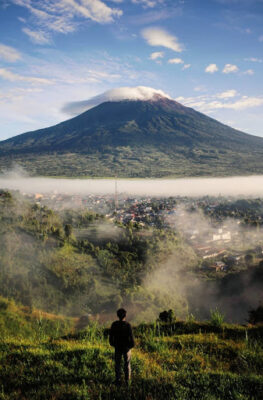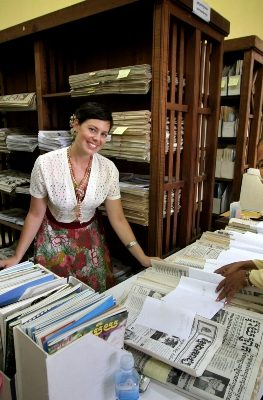Published on September 25, 2014
Commemorating 65 years of Indonesia-Belgium diplomatic relations, two special-edition stamps on the legendary Belgian cartoon character Tintin in his adventure to Kemajoran, – former airport of Jakarta – andthe Komodo Islands in “Flight 714”, were launched recently at the Brussels Square Panoramic Hall.
Launch of the special-edition stamps took place at the reception of Indonesia’s 69th independence Day, hosted by Indonesia’s Ambassador for Belgium, Luxembourg, and the European Union, Arif Havas Oegroseno, which was attended by designers from the Herge and Moulinsart Museum, and Belgium’s Deputy Foreign Minister, Jan Van Dessel.
The launch of the special edition stamps was the result of the good cooperation existing between the Indonesian Ambassador in Brussels with Herge and Moulinsart Museum, who are license-holders for Herge (creator of Tintin), as well as Belgium’s Post Office (B-Post), who designs the official stamps for Belgium. The two stamps will be used as official stamps of the Indonesian Ambassador in Brussels.
The widely popular Adventures of Tintin is a series of comic albums created by Belgian cartoonist Georges Remi in 1966, who wrote under the pen name Herge and became one the most popular European comicsin the 20th century. By the time of the centenary of Herge’s birth in 2007, Tintin had been published in more than 70 languages with sales of more than 200 million copies, and continues gaining new fans in the younger generation.
The series’ stories revolve around a young Belgian reporter by the name of Tintin, or Kuifje, who always found himself embroiled in thrilling adventures travelling around the world.
In the edition called “Flight 714” published in 1968, the adventurous Tintin found himself venturing into some of the islands in the Indonesian Archipelago. One of the scenes in the comic depicts Tintin arriving at Jakarta’s Airport, which at the time was located at the Kemayoran area. The edition also features the legendary Komodo Dragon and the Proboscis Monkey, that are endemic to the islands of Borneo (Kalimantan). The story goes that Tintin and his friends were forced to land in a small town on a remote island which was Mataram, on Lombok Island, West Nusatenggara Province.
The adventures of Tintin in “Flight 714” grew from a mere comic series to become a tying bond between Belgium and Indonesia. In 2011, some of the scenes depicting Tintin’s adventures in Indonesia were reproduced in the form of posters (60x80cm). The posters were handed by the Honorary Consul of Indonesia in Wallonia, Belgium, Eric Domb to the Indonesian Embassy. The posters decorate the main lobby of the Indonesian Embassy in Brussels to illustrate the long and close relationship existing between Belgium and Indonesia.
Eric Domb and Le Royaume de Ganesh
Eric Domb, official representative of Fanny Rodwell (widow of Herge), is official license holder of all of The Adventures of Tintin comic books. He is also a renowned Belgian businessman and initiator of Le Royauame de Ganesh (The Kingdom of Ganesha ) which contains the largest Pura (Balinese Hindu Temple) complex outside Indonesia. The temple complex itself is part of the Indonesian Park which encompassesa total area of 6 hectares and lies within the Parc Paradiso Bird Park, that covers a total area of 55 hectares.
Le Rayaume de Ganesh was officialy opened on 18th May 2011. Situated on a hilly area it resembles the Pura Besakih complex in Bali. The entire park complex itself is located about 1 hour’s drive from Brussels.
Eric Domb invested around 8 million Euro establishing the Indonesian park. The 8000 tons of stones needed to build the temples were especially brought from the city of Magelang in Central Java. The building of the park involved no less than 22 special carvers from Bali, 200 general stone carvers from all over Indonesia, and about 1000 stone workers.
The Hindu Temples are not merely an architectural feature but serve as an actual
religious site for Hindu devotees. Those who wish to enter the temple need to comply to religious requirements, just as in Bali.
The Kingdom of Ganesha is a reflection of Eric Domb’s deep affection for Indonesia. The complex is also expected to bring Indonesia closer to Europe and vice versa, besides showcasing the unique culture of Indonesia to the rest of the world.





